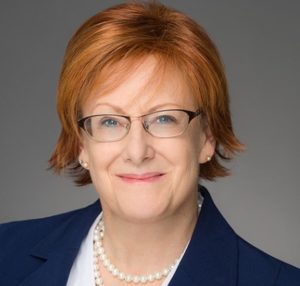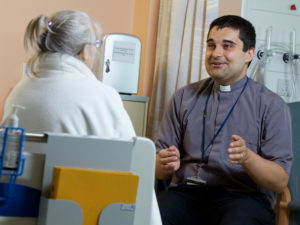Jennifer Ballentine is the Executive Director of the California State University Institute for Palliative Care. The Institute primarily teaches healthcare professionals about palliative care and the nuances of the field. The main Institute is hosted by CSU San Marcos, with campus partners at San Marcos, CSU Fresno and CSU Monterey Bay. The Institute is also in active outreach with several other campuses around the state.
Editor’s note: This interview has been edited for length and readability.

Credit: Jennifer Ballentine
Lucas: What’s the most popular course offered by the CSU Institute for Palliative Care?
Jennifer: Actually, we recently took a look at that information. Our most popular course by the number of students who have enrolled in it over time is our certificate in chaplaincy. Part of the reason for that is it was one of the first courses the Institute launched back in 2013. There are also not many courses out there that are specific to the chaplain role specifically around palliative care.
Lucas: What role does a chaplain serve when it comes to palliative care?
Jennifer: Chaplains occupy a couple of very important roles in palliative care. They’re there primarily to provide spiritual and what I call existential support to the patient. A person facing a serious illness, particularly one that is leading inexorably to death, faces a lot of assumptions regarding stability and identity, and a lot of issues that kind of “make up” a person’s understanding of the world, themselves and their future. That part of being ill is oftentimes ignored by physicians, nurses and even social workers, who are very focused on other important things. The chaplain is there to help the patient confront questions regarding what this all means for them.
Plus the chaplain offers support for the whole palliative care team because this is hard work. The team is dealing with people who are very ill every day, and they need support as well. What typically happens is a palliative care team in a hospital might comprise only a doctor and a nurse, and they’ll just grab any chaplain to come talk with them. But we want to make sure the chaplain has a firm grounding in palliative care.
Lucas: What are some more popular and/or interesting courses available through the Institute?
Jennifer: Actually our next most popular course is all about aromatherapy and its role in palliative care. When I first joined the Institute I thought to myself, “How do you teach a course about aromatherapy online?” Turns out there’s a kit that you buy that has all the essential oils and things that go along with the didactic material for the course.
We have another popular course called “Healing Through Art.” It’s one of our “Train the Trainers” classes, so the goal is that someone will take the course and then take the program into another setting. It’s popular among professional caregivers as well as patients and families who are trying to cope with an illness and the strain of caregiving through artistic expression.
Lucas: Do students who complete courses at the Institute “graduate?” Are there programs that culminate in degrees and/or certifications?
Jennifer: We do have hardcore, clinical-skills courses that culminate in Certificates in Palliative Care for advanced practice registered nurses (APRNs), registered nurses (RNs), social workers or chaplains. The curriculum really spans an interesting space. We offer very practical, skills-based courses that are instructor-led courses with a cohort moving through the course at the same time.
We don’t have a stackable certificate culminating in a master’s degree, which some universities offer. We’re really focused on workforce development more than academic preparation. But students do get a slew of continuing-education hours, which many clinical disciplines require for licensure. Many employers will also require their people to get a certain number of continuing education hours over the course of a year.
Students receive a certificate for several of the courses. To be clear, a certificate is different than a “certification.” A certification is conferred by a professional society, usually as a result of an exam. So we tell our certificate students, “This is not a certification, but it will set you up very powerfully to take that exam and pass it.”
Lucas: I see on the Institute’s website that you offer “organizational training.” How does that work?
Jennifer: You’re probably thinking of our “Core Concepts in Palliative Care” courses. These are intended for organizations to send their team through the same training. So a nurse, chaplain, physician and social worker could take the course, either at the same time or different times. It would give them all a foundation to understand the concepts and common language with which to talk about palliative care, as well as discipline-specific skills.

Chaplains serve an important role during palliative care.
Credit: medscape.com
Lucas: Is the Institute involved with awareness and/or public outreach regarding palliative care?
Jennifer: Our campus partners do a lot of work related to that. Many of them undertake outreach projects into their communities. They may sponsor “health fairs” that have advance care planning as the focus, or they’re developing training programs for family caregivers or going out and talking to high school students.
Our campus partner in San Marcos has a real focus on young caregivers. We’ve done surveys at different CSU campuses that found that something around 40 percent of our student population are caregiving for a relative in addition to their academic responsibilities. So it’s not just an older person problem, not just Baby Boomers who are caregivers. Campus partners have developed programs for high school students who are caregivers, as well as palliative care programs for health workers in Latino communities.
Lucas: How important are a patient’s family and loved ones in palliative care?
Jennifer: Palliative care is very focused on patients and families. Whether it’s in a hospital or in the home setting, the family is involved as much as the patient is. A large reason why palliative care teams are called upon is because there’s conflict within the family, conflict between what the patient wants and what the family wants. We want to try and get everybody on the same page. So paying attention to the family is fully integrated into all of our courses.
Lucas: Does palliative care change at all when practiced on children with serious illness?
Jennifer: It does a little bit. Palliative care has actually been available for children and adolescents longer than it has been for adults. It changes mainly because the patient is less in charge of the decision making. But that doesn’t mean that the patient is ignored. One of the poignant and common features of dealing with a child who’s seriously ill is that the parents are protecting the child, and vice versa. The parent doesn’t want the nurse to tell their child he or she is dying; the child doesn’t want the nurse to tell the parents he or she is dying. The palliative care team opens up the lines of communication to get people on the same page. And of course children are not just “little adults.” So there are differences physiologically, medically and psychosocially.
Lucas: Why do you think palliative care is so important?
Jennifer: Being sick is hard. Anything that can be done to soothe the experience, to relieve the suffering, should be done. However, there is a certain amount of suffering that honestly can’t be soothed. It’s hard to be sick; it’s hard to die. There will be suffering and grief attached to it all for both the patient and their loved ones. You can’t take it all away. But there’s certainly a lot you can take away.
A lot of pain is created by the medical interventions that are supposed to make you better. This is known as “iatrogenic harm.” It’s the harm that comes about as a result of someone trying to do something good for you. The simplest example is the pain of an injection or the achy arm the day after a flu shot. The balance between the pain you’re willing to put up with and the bigger benefits changes as you become seriously ill.
There can come a point where the pain and suffering induced by medical intervention outweigh the benefits a patient will receive. It’s at that point where palliative care is critically important for someone to interrupt that balance. We’ve actually discovered that when palliative care is involved early (ideally from the day of diagnosis), along with curative treatments, many people will live longer, and definitely will live better. Sometimes not much longer, but it’s all about how people feel.
Lucas: Do you have any tips or words of advice for anyone dealing with serious illness, their families and the role of palliative care?
Jennifer: The minute you are diagnosed with a serious illness, say to your doctor, “I would like to know more about palliative care and how that will help me cope with this.” Sometimes a doctor may not know what palliative care is. Another way to say it is, “Along with whatever you’re doing to cure me, I want to know my symptoms are looked after and my family is being supported and that my quality of life is a goal.” You need to make sure your doctor is paying attention to you as a person. Also, there’s a perception that palliative care is synonymous with foregoing curative treatments, and that receiving palliative care means you’ve “given up.” It’s supposed to be both/and: curative and palliative care should happen in tandem with each other.
Advance directives are also very important for really anyone over the age of 18. Run through scenarios with family members, make sure that you have a medical power of attorney to speak for you if you can’t. The main thing is to talk about it with your family members. You can’t assume they know what you want, because they probably don’t.
Lucas: Thank you so much Jennifer for taking the time to speak with me! I’ve learned so much from our conversation.
Jennifer: Thank you Lucas!
In case you missed it, you can find Part One of our interview with Jennifer Ballentine here.

 What Is the California State University Institute for Palliative Care?
What Is the California State University Institute for Palliative Care?


 “Making Mobiles” by Karolina Merska
“Making Mobiles” by Karolina Merska
 “Hands Up to the Sky” by Michael Franti & Spearhead
“Hands Up to the Sky” by Michael Franti & Spearhead
 Coping With Election Grief
Coping With Election Grief














